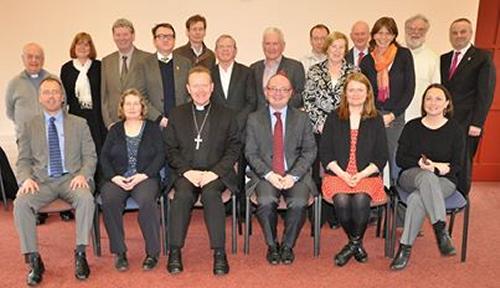
By Susan Gately - 27 February, 2014
In what was seen as a first, the Chairman of the Council of Communications for Bishops’ Conference, marked the 50th anniversary of Inter Mirifica, the Decree on Social Communications of the Second Vatican, by calling together a group of Catholic journalists.
Archbishop Eamon Martin met eighteen journalists in total at the Columba Centre in Maynooth.
They included editors of publications like the Irish Catholic, the Catholic Voice, Alive, Intercom, the Sacred Heart Messenger, Veritas and the Furrow.
There were also journalists working on internet sites like CatholicIreland.net, Sacred Space and iCatholic; those working with TV – EWTN and Kairos; those providing speakers for radio and television – Catholic Comment, and freelance journalists working across different media platforms such as The Tablet and the Catholic Times.
Looking at Inter Mirifica (the first words of the Encyclical in Latin meaning ‘Among the wonders’) Archbishop Martin noted how the document was “forward thinking” but also of its time.
It called on the Church to use the tools of the media, but the ‘tools’ mentioned were those of the day – press, radio and television. Today the document seemed “strangely dated”.
By contrast a more recent documen,t Proposal 18 from the 2012 Synod of bishops on ‘The New Evangelisation for the Transmission of the Christian Faith’ emphasised the use of electronic communications.
Addressing the challenges and opportunities available for Catholic journalists in Ireland, the Coadjutor Archbishop of Armagh said the Church had a huge reach.
“We underestimate the number of people who are part of the Church. Very few ‘organisations’ (for want of a better word) have that number gathering, about two million per week. We must think of those coming, rather than not coming.”
The “depth of our message” was also an opportunity, he said, contrasting with the often “skin deep” material coming from the media. “We are drawing on a tradition that has mystery, richness and diversity. We underestimate the richness of the message of Christ.”
Today it is easy to access Christian resource materials, the catechism, Scripture, the Church fathers – all available online. “It was more difficult to reach these materials in the past.”
A huge advantage in the Church is the ability to connect with people at local or parish level – in their homes or schools. “We are right there on the ground.”
But alongside the opportunities, came strong challenges, like the prejudice that Catholics faced.
“There is a pre-judgement before people hear what we say. Often before we have communicated something through the national or international media, many voices have caricatured what we are going to say and narrowed it down to a small number of issues,” he said.
 He added “Some people will say things about Catholics that they would not say about Muslims.”
He added “Some people will say things about Catholics that they would not say about Muslims.”
An aggressive secularism means that there can be a deep hostility towards religious views, and the ease of communication facilitated by the new media means people feel “more inclined to be aggressive and obscene than they would have been with the traditional media.”
He warned those present about the temptation to reply in kind to offensiveness, citing as a model of behaviour of which St Peter wrote: “Always be prepared to give an answer to everyone who asks you for the reason for the hope that you have. But do this with gentleness and respect.” (1Peter3)
Pointing out that the media operated on emotion and “what appeals to people’s emotions, stays with them”, he recalled the story of Savita Hallapanavar case, which became associated with the beautiful picture of a woman and the heartrending words of her husband.
“People were not interested in the findings of the enquiry – it is a challenge to get our message through that.”
The Coadjutor Archbishop of Armagh concluded saying that as the significance of the traditional media fades, people look to many different media – alternate TV stations and newspapers, apps, websites, twitter and social media. “It is a challenge and an opportunity to be part of that.”
He appealed for an “internal coherence” within the Church. “Sometimes we end up with various Catholic messages competing and sometimes appearing hostile to each other.”
By contrast he cited Pope Francis who has attracted many young people as followers on Twitter, and kept them “because he gives a great message every day”.
A rich discussion among the journalists followed, many of them thanking Archbishop Martin for the providing the opportunity to meet.